Geographical Distribution in Africa
Geographical Distribution of Banana weevil in Africa (red marked). Updated on 10 July 2019. Source Plantwise.
The banana weevil (C. sordidus) is known from virtually all banana-growing countries of the world, including the New World, Afrotropics, Oriental and Australasian regions.
General Information on Pest and Damage
Damage
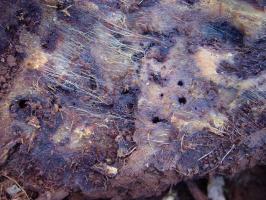 |
|
Banana corm damaged by banana weevil.Note tunnelling by weevil grubs and rotting of corm. |
|
© A. M. Varela, icipe
|
Grubs feed making irregular tunnels in the corm and rootstock. Tunnels are roughly circular and can reach up to about 8 mm in diameter. The corm can be riddle with tunnels, which promotes fungal infection and decay reducing it to a black mass of rotten tissue. Injury to the corm can interfere with root initiation and sap flow in the plant, as a result the leaves turn yellow, wither and die prematurely. In particular young suckers show symptoms of wilting and die, but older plants are retarded in their growth. Heavily infested plants produce small bunches, and are easily blown over by the wind. Spent stems, cut or standing are attacked rapidly.
Damage is worst in neglected plants. In fertile soils and with good crop husbandry it is seldom serious. Banana weevil numbers are often low in newly planted fields. Population build-up is slow and weevil problems are most often encountered in ratoon crops. The banana weevil damage is more serious in low altitude areas that in highland areas as a result of the influence of temperature. Weevils are usually not a problem beyond 1500 m above sea level (Karubaga and Kimaru, 1999; Gold and Messiaen, 2000).
Host range
Banana weevil is an important pest of banana and plantain (Musa spp.), and ensete (Ensete spp.). Weevil problems appear to be most severe in plantains, highland cooking bananas and ensete. The weevil has contributed to the decline and disappearance of highland cooking banana in parts of East Africa. Weevil pest status in other groups of bananas is variable. In commercial Cavendish plantations where the banana weevil has been reported to be relatively unimportant (Gold and Messiaen, 2000).
Symptoms
Infestation by the banana weevil begins at the base of the outermost leaf-sheath and in injured tissues at the lower part of the pseudostem. Initially the young grubs make several longitudinal tunnels in the surface tissue until they are able to penetrate to adjacent inner leaf-sheaths; they then bore into the pseudostem base and rhizome/corm, but also into the base of suckers and into roots. Larval tunnels may run for the entire length of fallen pseudostems. Infested plants have dull yellow green and floppy foliage. Young infested suckers often wither and fail to develop. Plants are easily blown down by mild to strong winds.
Affected plant stages
Flowering stage, fruiting stage, seedling stage and vegetative growing stage.
Affected plant parts
Roots and stems.
Symptoms by affected plant part
Roots: internal feeding
Stems: internal feeding
Biology and Ecology of the Banana Weevil
The eggs are elongate-oval, about 2 to 3 mm long and white in colour. Eggs are laid singly in small cavities that are chewed out by the female in the base of the pseudostem just above ground level, in the upper part of the corm, in roots near the soil surface and at the end of cut stems (stumps). Due to their white colour they are rarely seen in the corm tissue. The duration of the egg stage is very variable (4 to 36 days) depending on temperature. Hatching takes place after 6 to 8 days under tropical conditions.
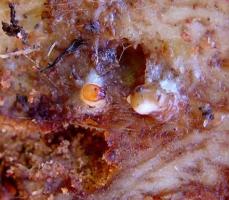 |
| Grubs of banana weevils in tunnel in banana corm. The fully-grown larva is about 1 cm long. |
|
© A. M. Varela, icipe
|
The larvae (grubs) are creamy white legless grubs, stout and distinctly curved and swollen in the middle of the body. The head is reddish-brown with strong mouthparts. Fully-grown grubs are about 12 mm long. Under tropical conditions, the larvae complete their development and pupate in 20 to 25 days.
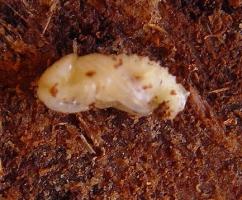 |
| Pupa of banana weevil is white and about 12 mm long (picture much enlarged). As it develops, the shape of the adult becomes visible. |
|
© A. M. Varela, icipe
|
Pupae are white and about 12 mm long. Pupation takes place in holes bored by the grubs. As it develops, the shape of the adult becomes visible. Adults emerge from the pupae 5 to 7 days after pupation.
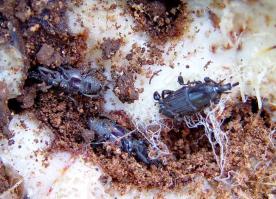 |
| Banana weevil |
|
© A.M. Varela, icipe
|
Adults are 10 to 16 mm long weevils (snout beetles), hard-shelled, with a rather long curved snout. Newly emerged weevils are red brown, turning almost black after a few days. They are free living They are most commonly found between leaf sheaths, in the soil at the base of the mat or associated with crop residues. They often remain within the plant before biting the external sheath and leaving the banana plant. They feed on dead banana plants, newly cut stems and other decaying plant material near the base of banana plants. Weevils may live for up to 2 years, and can live without food for 6 months, but are very sensitive to desiccation and will die within 48 hours if kept in a dry substrate. They are active at night. The adults are sluggish rarely fly, but commonly walk over the soil surface and vegetation and feign death when disturbed. Adults are not strong flyers and only cover short distances.
Pest and disease management
Pest and disease Management: General illustration of the concept of infonet-biovision

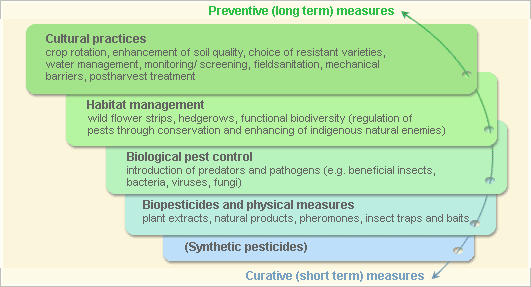
This illustration shows the methods promoted on infonet-biovision. The methods shown at the top have a long-term effect, while methods shown at the bottom have a short-term effect. In organic farming systems, methods with a long-term effect are the basis of crop production and should be of preference. On the other hand methods with a short-term effect should be used in emergencies only. On infonet we do not promote synthetic pesticides.
Further below you find concrete preventive and curative methods against Banana weevil.
Cultural practices
- Selecting vigorous healthy planting material obtained from plants free of weevils. Examine planting material by taking one or two slices from it. If grubs, pupae or tunnels are present, the material should be destroyed.
- Paring (trimming). If clean planting material is not available, the planting material should be pared (trimmed) to reduce the number of eggs and grubs. However, badly damaged suckers should not be used for planting. Paring allows for superficial inspection of the rhizome surface and rejection of suckers containing weevil damage. However, significant internal damage may be present on suckers in which the rhizome displays little evidence of attack. Paring and removal of outer leaf sheaths also helps to remove most weevil eggs and nematodes.
- Hot water treatment. Recommendations suggest immersing clean trimmed suckers in a bath with hot water at 52 to 55°C for 15 to 27 minutes before planting. There have been reports of hot water treatment killing remaining eggs and a high percentage of grubs. For example, Gettman et al. (1992) reported over 99% mortality of weevil eggs and grubs when suckers of dessert bananas were placed in a water bath of 43°C for 3 hours. However, other sources indicate that hot baths are very effective in eliminating nematodes, but kill only a third of the weevil grubs. Thus, hot water treatment of planting material is likely to provide protection against weevil for several crop cycles only (Gold and Messiaen, 2000).
A simple method for farmers to control temperature has been developed in Kenya. It consists of a pith block (of about 3 cm) or a small piece of wood tied to an iron plate (3 x 3 cm and weighing about 10 g) covered with a thin film of candle wax. This device is allowed to sink in a half-empty oil drum with water, in which the banana material to be treated is placed. Wood is burnt underneath the drum, when the temperature rises to 55°C the wax melts releasing the pith or piece of wood, which then floats to the surface. At this moment the firewood is removed. (Prasad and Seshu Reddy, 1994).
Do not replant previously infested land while old corms remain on the ground, or where insufficient time has passed for adult weevils to die after remnants of the previous crop has been removed.
Plant clean planting material as soon as possible in a new plantation. They should not be left overnight in heaps since they attract weevils and could be reinfested before planting.
Harvesting of all mature pseudostems at certain intervals, rather than continually, is suggested as a preventive measure of control. This discourages the continuous breeding of the weevil. (CABI).
Avoid moving infested plant material from plantation to plantation as this will spreads banana weevils.
Sanitation
Practice good crop hygiene:
- Cut old stems after harvesting at ground level. Covering the cut rhizome with a layer of soil is said to prevent the weevil's entry and egg laying.
- Cut old stems as soon as the bunch is harvested and wind-damaged pseudostems (stumps) into small pieces and scatter them so that they quickly dry and thus do not attract the weevils. Alternatively, they can be cut into larger pieces and use for trapping weevils (see below)
- Dig out and remove old corms, trash and other materials in which weevils may breed.
Practice good crop husbandry to produce vigorous banana plants, which are more able to tolerate weevil damage:
- Use mulch. Spread mulch away from banana stool leaving a clear ring of about 60 cm from the base of the stool to keep the roots from growing towards the surface, and to avoid moist conditions near the stool, which attracts banana weevils.
- Desucker and remove water suckers regularly
- Clean mats of dead leaves and plant debris
- Keep the plantation free of weeds at all times.
- Ensure proper fertilization. Application of manure is important in the early stages of growth of the banana plant.
Biological pest control
Natural enemies
Some fungi (e.g. Beauveria bassiana and Metarhizium anisopliae) have shown efficacy as control agents of this pest. Some of them caused weevil mortality of over 90%. In Cuba, the fungus Beauveria bassiana is reported to be effective against the banana weevil in combination with ants (CABI, 2000). However, there is little information on the performance under field conditions. Moreover, the distribution and application of these biocontrol agents are still restricted by lack of facilities and high costs.
Some nematodes, (Steinerma and Heterorhabditis spp.) attack both adults and grubs in the field, but economic cost and their efficacy limit their use on a large scale (Gold and Messiaen, 2000).
Biopesticides and physical methods
Neem (Azadirachta indica)
Applications of neem powder effectively controlled weevils and nematodes in on-farm trials and in farmer's fields in Kenya. Application of 60 to 100 g of neem seed powder or neem cake at planting and then at 4 months intervals significantly diminished pest damage and increased yields. Application of over 100 g or neem oil was phytotoxic (harmful to plants) and uneconomical.
Neem applications were economical in fertile soils with moderate pest infestation. Neem applications to banana plants grown in poor soil and under very high pest attack were uneconomical. A combination of application of cow dung and neem treatments resulted in yield increases of 50 to 75% (Musabyimana, 1999). Dipping suckers in a 20% neem seed solution at planting protects the young suckers from weevil attack by reducing egg laying through its repellent effect on adult weevils. Egg hatching rates may also be lowered in neem-treated plants (Gold and Messiaen, 2000). For more information on Neem click here.
Trapping
Disc-on-stump traps and old pseudostems can be used for trapping weevils. Disc-on-stump traps consist of corm slices placed on top of harvested plants cut at the rhizome. Old pseudostems can be cut into lengths of 20 to 60 cm and split each length, and placed on the ground near the corm bases with the cut surface downwards. Adult weevils are attracted to the cut stems or corms for shelter, to feed and to lay eggs. When the eggs hatch the life cycle cannot continue as the cut pieces dry out and the grubs die from desiccation. The weevils can be collected by hand and destroyed. The efficiency of the traps depends on their numbers and frequency of trapping. Disk-on-stump traps collect 3 to 7 times as many weevils as pseudostem traps.
Information Source Links
- Abera-Kalibata, A. M., Gold, C. S, Van Driesche, R. G. and Ragama, P. E. (2007). Composition, distribution, and relative abundance of ants in banana farming systems in Uganda. Biological Control. Volume 40, issue 2, February 2007, Pages 168-178.
- Treverrow N. (1985). Banana weevil borer. Agfact H6.Ae.1. Department of Agriculture, New South Wales. Addex 231/622.
- Gold C.S. and Messiaen S. (2000). The banana weevil. Cosmopolites sordidus. Pest Fact Sheet No 4. www.bioversityinternational.org
- CABI. (2000): Crop Protection Compendium, Second Edition. © CAB International Publishing. Wallingford, UK. www.cabi.org
- CABI. (2004): Crop Protection Compendium, 2004 Edition. © CAB International Publishing. Wallingford, UK. www.cabi.org
- Gettman A.D., Mitchell W.C., Li P, Mau R.F.L., (1992). A hot water treatment for control of the banana root borer, Cosmopolites sordidus (Germar) (Coleoptera: Curculionidae) in banana planting stock. Proceedings of the Hawaiian Entomological Society, 31:59-63.
- Hill, D. (1983). Agricultural insect pests of the tropics and their control. 2nd edition. Cambridge University Press. ISBN: 0-521-24638-5.
- Kranz, J., Schmutterer, H. and Koch, W. (1977). Diseases, pests and weeds in tropical crops. Verlag Paul Parey. ISBN: 3-489-68626-8.
- Musabyimana T., Saxena R. C., Kairu E. W., Ogol C.P.K.O., Khan Z. R. (2001). Effects of Neem Seed Derivatives on Behavioral and Physiological Responses of the Cosmopolites sordidus (Coleoptera: Curculionidae). Journal of Economic Entomology 94: 449-454.
- Musabyimana, T. (1999). Neem seed for the management of the banana weevil Cosmopolites sordidus Germar (Coleoptera: Curculionidae) and banana parasitic nematodes. PHD Thesis. Icipe
- Tree Crop Propagation and Management - A farmer-trainer training manual. Integration of Tree Crops into Farming Systems Project (ITFSP) GTZ and MoARD (Kenya). October 2002.
